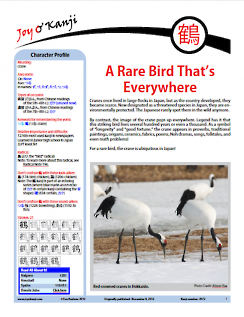鶴
crane
Kanji 2072
Thank you for visiting this Character Home Page. Below you'll find a synopsis of the essay. If you wish to read the full text, the PDF of the essay is available for purchase to the right.
Cranes once lived in large flocks in Japan but have since become scarce. By contrast, the image of the crane pops up everywhere. As a symbol of “longevity” and “good fortune,” this bird appears in proverbs, paintings, ceramics, poems, Noh dramas, songs, folktales, and even math problems! Find out about the significance of folded paper cranes and the true story of Sadako Sasaki.
Revision history:
Sept. 30, 2024: p. 7: Revised the caption to indicate that multiple shops are affected, not just one.
May 9, 2024: p. 15: Deleted a broken link.
June 6, 2021:
- p. 2: Replaced the Henshall etymology.
- p. 20: Added a link to the Kanshudo games.
Jan. 30, 2018: Fixed some broken links. Also corrected the last kanji in an artist's name on p. 17. The name should be written as 伊藤若冲.
Dec. 5, 2014: Made several changes:
- p. 2: It previously said, "The middle kanji, 之, is also non-Joyo and is the old way of writing the possessive の." I changed "the old way" to "an old way" because there are other old ways.
- p. 4 sidebar: Changed the definition of 潮 (しお) from "salt" to "tide."
- p. 12: It used to say -年 (-ねん: counter for years), which is wrong in this context. I changed it to 年 (ねん: year).
Nov. 9, 2012: Originally published.



Comments